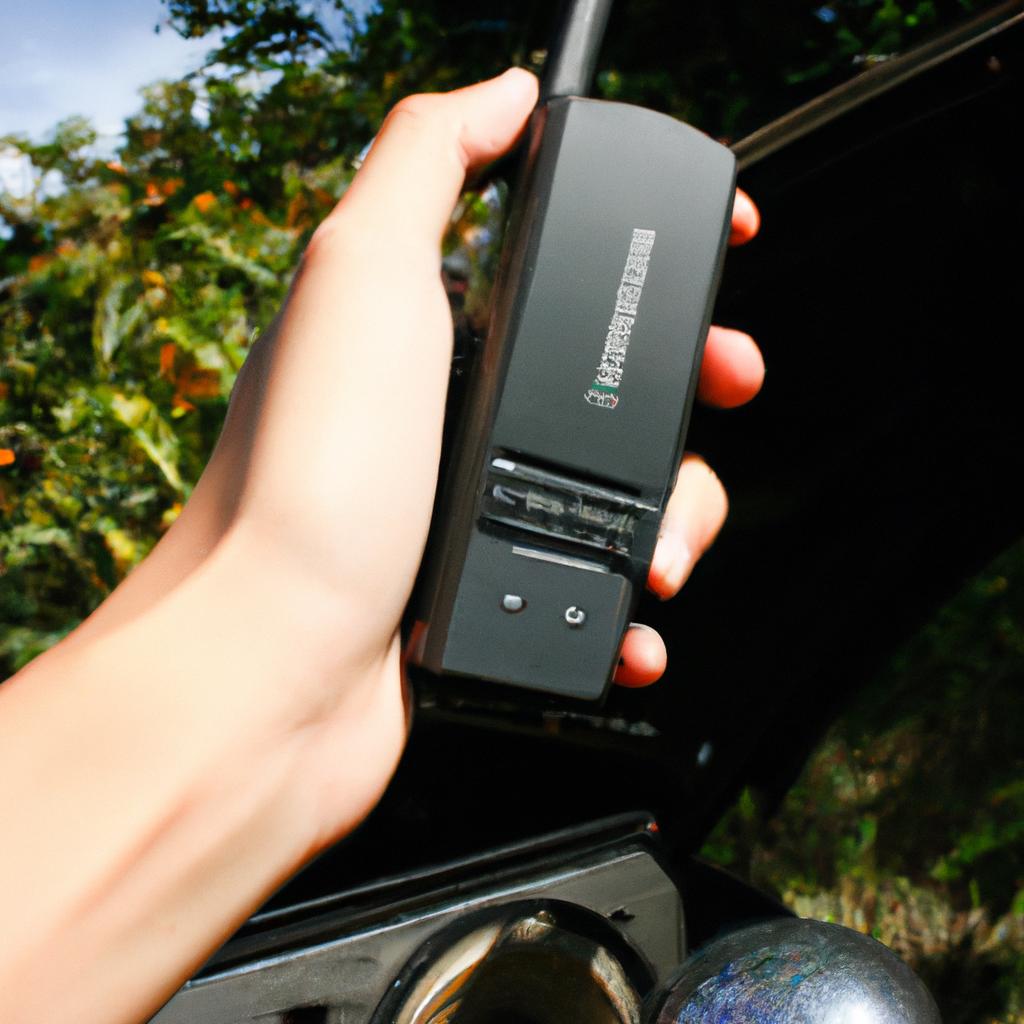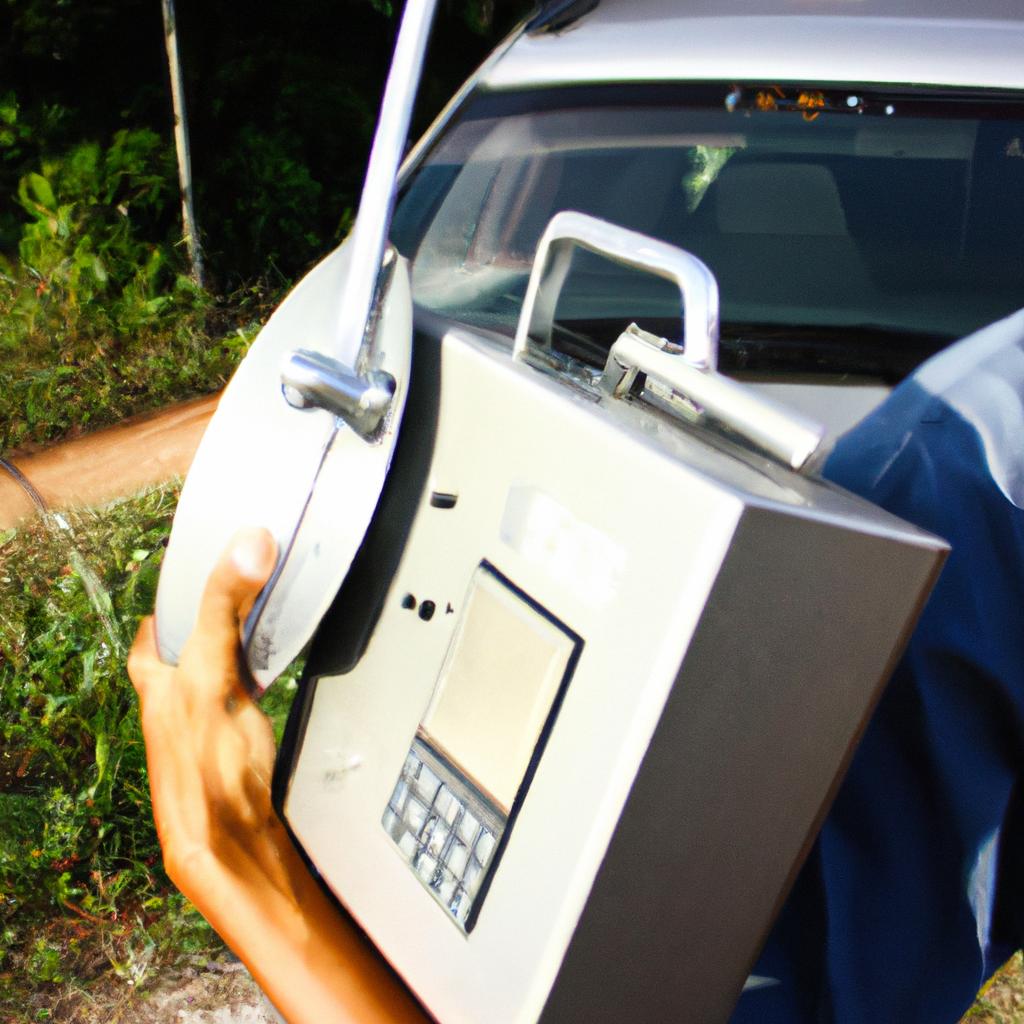The quality of AM reception has long been a topic of interest and concern among radio enthusiasts, engineers, and listeners alike. The ability to receive clear and uninterrupted signals on the AM frequency band is crucial for effective communication and enjoyment of various forms of media content. In this article, we will delve into an informational overview of AM reception in the context of radio, exploring the factors that affect it and strategies for improving its performance.
To illustrate the significance of AM reception, let us consider a hypothetical scenario where a community heavily relies on AM radio stations for critical emergency updates during natural disasters. Imagine a region prone to severe storms or earthquakes; timely information regarding evacuation routes, shelter locations, and weather conditions can be life-saving. However, if the AM reception is compromised due to interference or other technical issues, these vital messages may not reach those who need them most. Understanding how AM reception works and learning about potential challenges will enable us to address any obstacles effectively, ensuring reliable transmission regardless of external circumstances.
In the following sections, we will explore topics such as antenna design, atmospheric conditions’ impact on signal propagation, interference sources like power lines or electronic devices, receiver sensitivity and selectivity characteristics, as well as practical tips to enhance AM reception. By gaining insights into these By gaining insights into these topics, we can make informed decisions and implement strategies to improve AM reception. For example, understanding antenna design can help us choose the right type of antenna and position it in an optimal location for maximum signal strength. Additionally, being aware of atmospheric conditions such as ionospheric disturbances or thunderstorms can help us anticipate potential disruptions and adjust our reception accordingly.
Identifying sources of interference, such as nearby power lines or electronic devices, allows us to mitigate their impact by employing filters or relocating the receiver away from these sources. Receiver sensitivity and selectivity characteristics play a crucial role in capturing weak signals and rejecting unwanted noise or adjacent channel interference. Familiarizing ourselves with receiver specifications helps us choose equipment that is better suited for reliable AM reception.
In addition to technical considerations, there are practical tips that can significantly enhance AM reception. These include using external antennas instead of relying solely on built-in ones, ensuring proper grounding for improved signal stability, minimizing obstructions between the antenna and transmitter, and avoiding overloading the receiver with strong local stations.
Overall, by delving into the factors affecting AM reception and utilizing strategies to overcome challenges, we can enjoy clearer signals and more reliable communication through this important frequency band. Whether it’s for staying informed during emergencies or simply enjoying our favorite radio programs without interruption, optimizing AM reception is vital for a fulfilling listening experience.
AM radio frequencies and their characteristics
AM radio frequencies, also known as Amplitude Modulation, are a significant part of the radio spectrum. These frequencies typically range from 535 kilohertz (kHz) to 1705 kHz in North America and vary slightly in other regions across the globe. Understanding their characteristics is essential for comprehending how AM reception works.
To illustrate, let’s consider an example: imagine you’re driving through a rural area with rolling hills and sparse population. As you tune your car radio to an AM station, you may notice that the signal becomes weaker or even fades away altogether when passing through certain areas. This phenomenon occurs due to several factors related to AM frequencies.
Firstly, atmospheric conditions greatly influence AM reception. During thunderstorms or periods of intense solar activity, disturbances can occur in the ionosphere— a region of charged particles surrounding Earth. These disturbances affect the propagation of AM signals over long distances, resulting in reduced reception quality.
Secondly, physical obstacles such as hills, buildings, or dense vegetation can obstruct the path between the transmitting antenna and the receiving device. These obstructions weaken the strength of the signal received by a listener located behind them, leading to decreased clarity and potentially causing interference.
Thirdly, electrical interference from various sources can disrupt AM reception. For instance, power lines running near transmission towers or electronic devices operating nearby might generate electromagnetic fields that interfere with AM signals. Consequently, this interference manifests as static noise or distortions on the received audio.
Lastly, man-made structures like metal bridges or tunnels create reflections and multipath effects that impact AM waves’ travel paths. When a transmitted signal bounces off these structures before reaching its intended destination (the receiver), it leads to overlapping waves arriving at different times. This results in phase cancellations and fluctuations in amplitude—affecting overall reception quality.
Understanding these aspects enables us to appreciate why AM reception quality varies under different circumstances. Factors such as atmospheric conditions, physical obstacles, electrical interference, and reflections from man-made structures all play a significant role in shaping the AM radio experience.
Moving forward to explore factors affecting AM reception quality, we delve deeper into the specific elements that can enhance or hinder signal clarity.
Factors affecting AM reception quality
Section Title: Factors Influencing AM Reception Quality
Transitioning from the previous section on AM radio frequencies and their characteristics, it is crucial to understand the various factors that can influence the quality of AM reception. To illustrate this, let us consider a hypothetical scenario where an individual living in a densely populated urban area experiences poor AM reception due to interference from nearby electronic devices.
-
Interference from Electronic Devices:
The proliferation of electronic devices in modern society poses a significant challenge to AM reception. With numerous gadgets emitting electromagnetic signals, there is a higher probability of signal distortion or complete loss when these signals interfere with the desired AM frequency. In our example, the individual’s proximity to multiple electronic devices such as smartphones, Wi-Fi routers, and microwave ovens might be causing disruptions in their AM reception. -
Distance from Transmitter Station:
The distance between the listener and the transmitter station plays a vital role in determining AM reception quality. As the listener moves away from the transmitter station, signal strength diminishes gradually, leading to weaker reception even if no other interferences are present. If our hypothetical individual resides far away from any transmitting stations amidst tall buildings and concrete structures, they may experience reduced signal strength resulting in poorer reception. -
Atmospheric Conditions:
Atmospheric conditions also impact AM reception by influencing how radio waves propagate through space. Changes in atmospheric pressure, humidity levels, temperature inversions, and solar activity can affect signal propagation over long distances. For instance, during thunderstorms or periods of high solar flare activity, electrical disturbances within Earth’s atmosphere disrupt radio wave transmission paths and weaken overall signal strength. -
Geographical Features:
Geographical features like mountains or hills obstruct radio wave propagation and impact AM reception quality for listeners located behind them. The presence of large bodies of water can also cause reflections or diffractions that affect signal integrity differently depending on specific circumstances.
To further emphasize these influences visually:
-
Factors impacting AM Reception Quality:
- Interference from Electronic Devices
- Distance from Transmitter Station
- Atmospheric Conditions
- Geographical Features
| Factors impacting AM Reception Quality |
|---|
| Interference from Electronic Devices |
| Geographical Features |
In summary, various factors contribute to the quality of AM reception. In our hypothetical scenario, interference from nearby electronic devices, distance from transmitter stations, atmospheric conditions, and geographical features collectively impact the individual’s ability to receive clear AM signals. Understanding these influences is crucial in devising strategies for improving overall reception.
Transitioning into the subsequent section about “The role of antennas in AM reception,” we will explore how antenna design and placement can further enhance the listener’s experience without interruption or distortion.
The role of antennas in AM reception
Factors Affecting AM Reception Quality
In the previous section, we explored the various factors that can impact the quality of AM reception. Now, let us delve deeper into how antennas play a crucial role in ensuring optimal AM reception.
Imagine a scenario where you have just purchased a brand new AM radio receiver and eagerly tune it to your favorite station. However, instead of crisp and clear audio, all you hear is static and interference. This frustrating experience highlights the importance of understanding how antennas contribute to the overall reception quality.
To better comprehend this concept, let’s explore four key elements related to antennas and their influence on AM reception:
-
Antenna Height: The height at which an antenna is installed greatly affects its ability to capture signals effectively. Higher placement allows for improved line-of-sight with transmitting towers, reducing obstructions such as buildings or trees that could hinder signal strength.
-
Antenna Length: The length of an antenna determines its resonance frequency, directly impacting the frequencies it can receive optimally. For example, longer wire antennas are generally more efficient in capturing lower-frequency AM signals compared to shorter ones.
-
Antenna Orientation: The orientation or directionality of an antenna plays a vital role in receiving specific stations. By aligning the antenna parallel to the transmission tower’s direction, one can maximize signal strength while minimizing unwanted interference from other directions.
-
Antenna Type: Different types of antennas possess varying characteristics and capabilities when it comes to picking up AM signals effectively. Common types include whip antennas (commonly found in portable radios), loop antennas (used for directional tuning), and external wire antennas (allowing for increased range).
Now that we have established some fundamental principles regarding factors affecting AM reception quality related specifically to antennas, let us proceed further into exploring common issues faced by individuals when attempting to achieve optimal reception and useful troubleshooting techniques.
Common issues and troubleshooting techniques
The Impact of Environmental Factors on AM Reception
Consider the following scenario: You are sitting in your car, tuned into your favorite AM radio station. Suddenly, the signal starts to fade and becomes filled with static interference. Frustrated, you try adjusting the antenna or changing positions within the vehicle, but nothing seems to improve the reception. This common issue highlights the influence of various environmental factors on AM reception.
Several external elements can significantly affect the quality of AM signals received by radios. These factors include atmospheric conditions such as thunderstorms or solar flares that can disturb radio waves over long distances. For instance, during a severe storm, electromagnetic disturbances in the atmosphere may cause interruptions or complete loss of signal transmission.
Additionally, geographical features like mountains or tall buildings can obstruct radio waves and lead to reduced signal strength in certain areas. Similarly, dense foliage or densely populated urban environments can also hinder AM reception due to high levels of electromagnetic noise generated by electronic devices and power lines.
To provide further insight into how these environmental factors impact AM reception, consider the following list:
- Atmospheric disturbances caused by inclement weather
- Geographical obstacles like mountains or tall structures
- Electromagnetic interference from urban environments
- Signal degradation due to obstructions
| Factor | Impact | Example |
|---|---|---|
| Atmosphere | Disrupted transmissions | Thunderstorm causing signal loss |
| Geography | Reduced signal strength | Mountain range blocking signals |
| Urban settings | Increased interference | High-density residential area |
| Obstructions | Degraded signal quality | Dense forest hindering reception |
Understanding how these environmental factors affect AM reception is essential for troubleshooting any issues you might encounter. By recognizing and addressing these challenges appropriately, you can optimize your listening experience regardless of potential disruptions.
Transitioning into our next section about “AM reception in urban versus rural areas,” it is important to note that environmental factors can have varying impacts depending on the location.
AM reception in urban versus rural areas
AM Reception in Urban versus Rural Areas
In the previous section, we discussed common issues and troubleshooting techniques related to AM reception. Now, let us delve into a comparison of AM reception in urban and rural areas. To illustrate this difference, consider the following scenario:
Imagine two individuals living in different locations – one residing in a bustling city with towering skyscrapers, while the other dwells in a serene countryside surrounded by vast open spaces. Both decide to tune their radios to an AM station broadcasting news updates.
Urban environments present unique challenges for AM reception due to high levels of electromagnetic interference caused by numerous electronic devices and structures. As a result, listeners may experience frequent signal disruptions or static noise. In contrast, rural areas generally have less interference, allowing for clearer reception and improved audio quality.
- Signal Strength: Urban areas often exhibit weaker signals due to obstacles like tall buildings, which can block or reduce radio waves from reaching receivers effectively.
- Interference Sources: The density of electrical equipment and infrastructure such as power lines and transformers contributes significantly to increased interference levels in cities.
- Multipath Propagation: Reflections from buildings cause multipath propagation where multiple versions of the same signal reach receivers at slightly different times, leading to distorted audio.
- Noise Floor: With higher background noise levels resulting from various sources (e.g., traffic), distinguishing weak AM signals becomes more challenging amidst the cacophony.
Now, let’s visualize some key differences between urban and rural AM reception using a comparative table:
| Aspect | Urban Area | Rural Area |
|---|---|---|
| Signal Strength | Weaker | Stronger |
| Interference | High | Low |
| Multipath Propagation | More pronounced | Less significant |
| Noise Floor | Higher | Lower |
Understanding the variations in AM reception between urban and rural areas provides valuable insights for both radio listeners and industry professionals. By recognizing these factors, individuals can make informed decisions on antenna placement, receiver selection, or even explore alternative means of accessing AM broadcasts.
In the subsequent section about future prospects and advancements in AM reception technology, we will examine how ongoing developments aim to address some of the challenges faced by both urban and rural listeners.
Future prospects and advancements in AM reception technology
In the previous section, we explored the differences in AM reception between urban and rural areas. Now, let us delve deeper into some of the challenges faced by radio listeners when it comes to AM reception across various environments.
Consider a hypothetical scenario where Jane, an avid radio enthusiast living in a suburban neighborhood, experiences inconsistent AM reception on her vintage radio set. Despite being located within reasonable proximity to broadcasting stations, she often encounters interference and static that disrupts her listening experience. This example illustrates how factors beyond geographical location can influence AM reception quality.
To better understand these challenges, let’s examine some key considerations:
- Electromagnetic Interference: Various electronic devices such as power lines, appliances, or even nearby buildings can generate electromagnetic fields that interfere with AM signals. These interferences result in signal degradation and poor overall reception.
- Natural Obstructions: Natural barriers like hills or dense forests may obstruct the path of AM radio waves, causing attenuation or complete signal loss. In remote rural areas surrounded by mountains or thick vegetation, this obstruction can significantly impact reception range and clarity.
- Man-Made Structures: Tall buildings and infrastructure in urban areas can create multipath propagation issues for AM signals. Multipath occurs when signals bounce off multiple surfaces before reaching the receiver antenna, leading to phase cancellation and distortion.
- Noise Levels: Environmental noise from sources like traffic, industrial machinery, or electrical equipment generates unwanted background noise that affects audio quality during AM transmission.
Let us now analyze these challenges more comprehensively through a table:
| Challenge | Description | Impact |
|---|---|---|
| Electromagnetic Interference | Generated by electronic devices and nearby structures; causes signal degradation | Poor reception quality |
| Natural Obstructions | Hillsides or dense foliage blocking signal paths; results in attenuated or lost signals | Limited reception range |
| Man-Made Structures | Tall buildings and infrastructure causing multipath propagation; leads to phase cancellation and distortion | Distorted audio |
| Noise Levels | Background noise from traffic, machinery, or electrical equipment; interferes with AM transmission and affects audio quality | Reduced clarity and listening pleasure |
Understanding these challenges is crucial for both radio enthusiasts like Jane and professionals working in the field of radio technology. By recognizing these factors, we can strive towards developing improved AM reception systems that overcome these limitations.
In conclusion, while AM reception has its own unique set of challenges across different environments, advancements in technology continue to address some of these issues. The next section will explore future prospects and developments in AM reception technology, shedding light on potential solutions to enhance overall user experience.
[Next Section: Future prospects and advancements in AM reception technology] K7BUC
K7BUC



